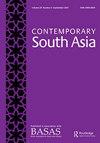北方邦拉延人的社会流动性和种姓政治化
IF 0.8
3区 社会学
Q3 AREA STUDIES
引用次数: 2
摘要
本文考察了种姓组织在边缘化穆斯林birādarī社会流动过程中的作用,特别关注拉因(蔬菜小贩)种姓。本文描绘了种姓panchāyat、协会和基金会,突出了它们在社会流动和政治代表过程中的各自作用和功能。我展示了各个组织在整个过程中相互补充。种姓panchāyat依靠种姓集团首领(chaudhari)的传统权威来规范birādarī成员的内部事务。种姓协会试图巩固该群体的集体认同,促进团结,以便在选举过程中施加影响。最后,种姓成员还在地方一级经营组织,如Rayeen基金会,试图扩大他们的活动范围,超越birādarī,呼吁普遍原则。这些组织共同努力为拉延人争取更高的地位。这篇文章的贡献在于强调了多个种姓组织之间的相互作用,促进了群体身份的转变,以及被边缘化的穆斯林种姓群体所经历的社会流动过程。本文章由计算机程序翻译,如有差异,请以英文原文为准。
Social mobility and politicisation of caste among the Rayeens of Uttar Pradesh
ABSTRACT
This article examines the role of caste organisations in the process of social mobility of a marginalised Muslim birādarī, focusing specifically on the Rayeen (vegetable sellers) caste. The article maps the caste panchāyat, association, and Foundation, highlighting their respective role and function in the process of social mobility and political representation. I show that the various organisations complement each other in the overall process. Caste panchāyat relies on the traditional authority of the head of the caste group (the chaudharī) to regulate the internal affairs of birādarī members. The caste association attempts to consolidate the group’s collective identity and foster unity to exert influence in the electoral process. Finally, caste members also run organisations at the local level, such as the Rayeen Foundation, trying to expand the reach of their activities beyond the birādarī, appealing to universal principles. Collectively these organisations strive to claim a higher status for the Rayeens. The article’s contribution is to highlight the interactions between the multiple caste organisations in facilitating the transformation of group identity and the process of social mobility experienced by a marginalised Muslim caste group.
求助全文
通过发布文献求助,成功后即可免费获取论文全文。
去求助
来源期刊

Contemporary South Asia
AREA STUDIES-
CiteScore
2.10
自引率
0.00%
发文量
82
期刊介绍:
The countries of South Asia - Bangladesh, Bhutan, India, Maldives, Nepal, Pakistan and Sri Lanka - are internally diverse and part of global flows of people, goods and ideas. Contemporary South Asia seeks to address the issues of the region by presenting research and analysis which is both cross-regional and multi-disciplinary. The journal encourages the development of new perspectives on the study of South Asia from across the arts and social sciences disciplines. We also welcome contributions to pan-regional and inter-disciplinary analysis. Our aim is to create a vibrant research space to explore the multidimensional issues of concern to scholars working on South Asia and South Asian diasporas in the postcolonial era.
 求助内容:
求助内容: 应助结果提醒方式:
应助结果提醒方式:


